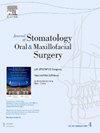Does the modified inferior border osteotomy improve the surgical outcomes in bilateral sagittal split osteotomy?
IF 1.8
3区 医学
Q2 DENTISTRY, ORAL SURGERY & MEDICINE
Journal of Stomatology Oral and Maxillofacial Surgery
Pub Date : 2024-10-23
DOI:10.1016/j.jormas.2024.102122
引用次数: 0
Abstract
Background
To investigate the effect of lower border osteotomy on the lingual split pattern and IAN in BSSO procedures.
Materials and Methods
The study comprised 32 patients (64 operated sides) who underwent bilateral sagittal split osteotomy (BSSO) due to dentofacial abnormalities between the periods of April 2021 and April 2022. In the mandible, 32 sides (the conventional group) received standard BSSO surgery, while 32 sides (the modified group) additionally received lower border osteotomy. Data regarding the split difficulty of the mandibular in BSSO surgery and the recovery status of the inferior alveolar nerve (IAN) one year after surgery were obtained and evaluated from patient records. The fracture line was radiographically evaluated for the lingual split pattern following surgery.
Results
A statistically significant difference was observed in favor of the modified group when the mandibular split difficulty of the groups was compared (p = 0.032). The split time of the modified group was found to be statistically shorter than the conventional group (p ≤ 0.001). The mean numbness level of the modified group one year after surgery was statistically significantly lower than that of the conventional group (p = 0.019). Although there was no statistically significant difference between the two groups in terms of lingual fracture pattern, the rate of type 1 (87.5 %) fracture was higher in the modified group compared to the other group (68.8 %) (p = 0.089).
Conclusion
The lower border osteotomy performed in addition to the conventional BSSO surgery allows the split procedure easier and in a shorter time. The modification resulted in an increased incidence of type 1 lingual fracture pattern in the mandible. The neurosensory recovery capacity of the IAN in the postoperative period is higher in areas where lower-border osteotomies are performed.
改良下缘截骨术能否改善双侧矢状面劈裂截骨术的手术效果?
背景:研究下缘截骨术对 BSSO 手术中舌裂模式和 IAN 的影响:材料与方法:研究对象包括2021年4月至2022年4月期间因颌面部异常而接受双侧矢状面劈裂截骨术(BSSO)的32例患者(64个手术侧)。在下颌骨方面,32 侧(常规组)接受了标准 BSSO 手术,而 32 侧(改良组)则额外接受了下缘截骨术。从患者病历中获取并评估了下颌骨在 BSSO 手术中的分割难度以及术后一年下牙槽神经(IAN)的恢复情况。术后对骨折线的舌侧劈裂模式进行了放射学评估:比较两组的下颌劈裂难度,发现改良组的差异有统计学意义(P=0.032)。经统计学处理,改良组的劈叉时间短于传统组(P≤0.001)。改良组术后一年的平均麻木程度在统计学上明显低于传统组(p = 0.019)。虽然两组患者的舌骨骨折形态无统计学差异,但改良组的1型骨折率(87.5%)高于另一组(68.8%)(P=0.089):结论:在传统 BSSO 手术的基础上进行下缘截骨,可使分割手术更简单、时间更短。结论:在传统 BSSO 手术的基础上进行下缘截骨,可使分割手术更简便、时间更短,同时也增加了下颌骨 1 型舌骨骨折的发生率。在进行下边界截骨术的地区,术后 IAN 的神经感觉恢复能力更高。
本文章由计算机程序翻译,如有差异,请以英文原文为准。
求助全文
约1分钟内获得全文
求助全文
来源期刊

Journal of Stomatology Oral and Maxillofacial Surgery
Surgery, Dentistry, Oral Surgery and Medicine, Otorhinolaryngology and Facial Plastic Surgery
CiteScore
2.30
自引率
9.10%
发文量
0
审稿时长
23 days
 求助内容:
求助内容: 应助结果提醒方式:
应助结果提醒方式:


